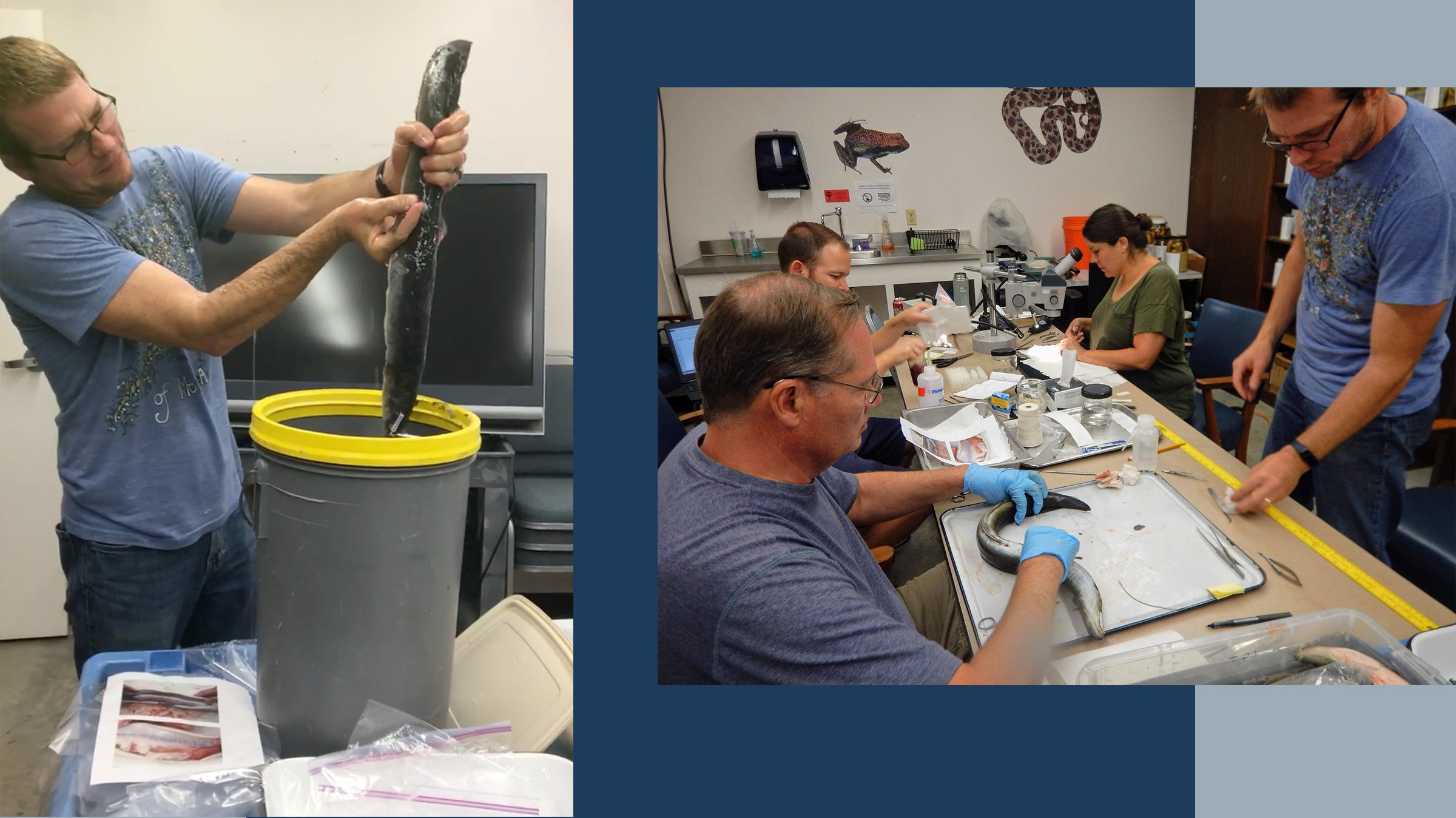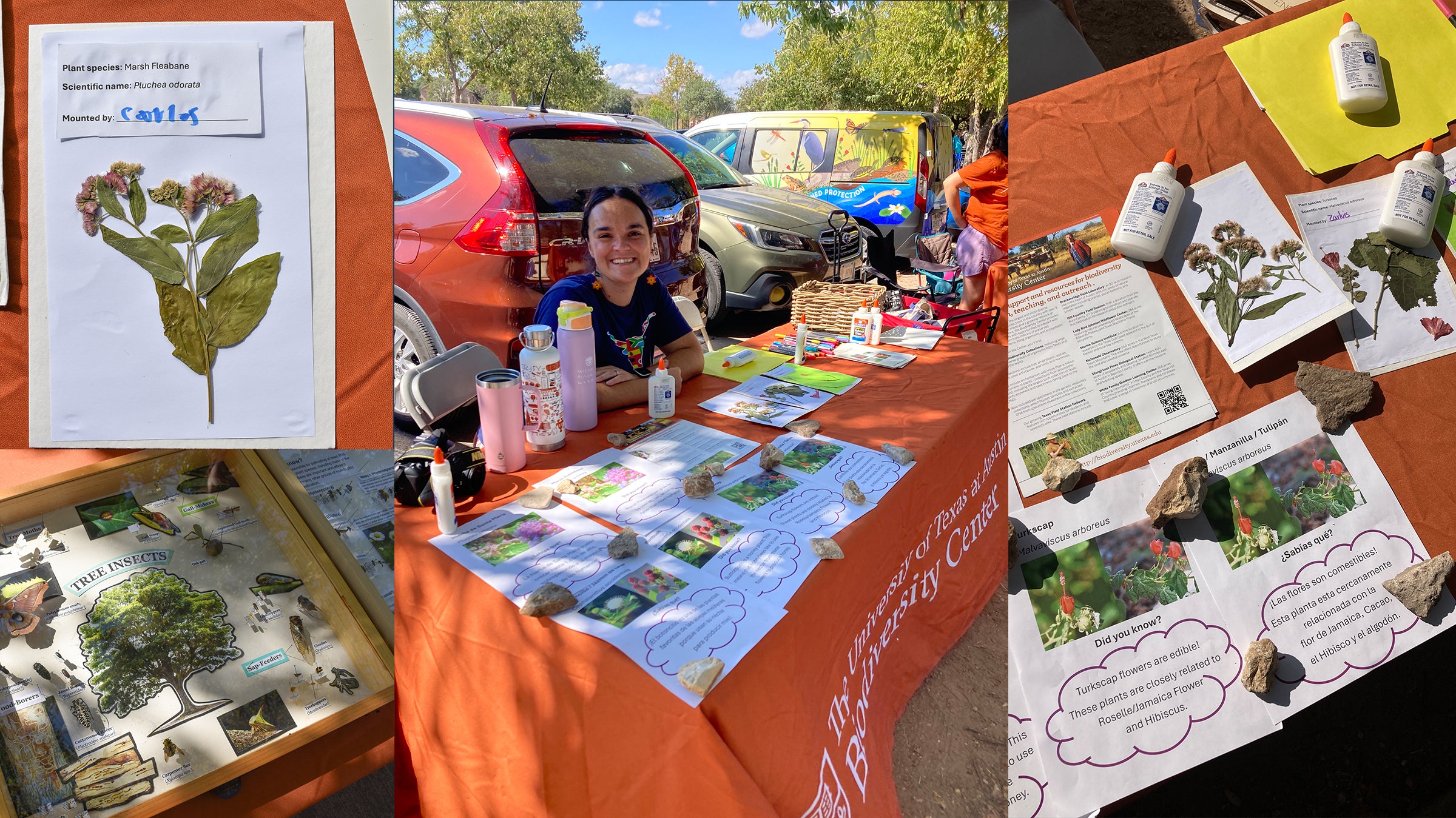
Left: Pulling eels out of a bucket of ice water demonstrates how difficult eels are to hold and not to mention their ability to produce copious slime. CLICK HERE TO SEE VIDEO. Right: Kevin Mayes (TPWD), Stephen Curtis (TPWD), Melissa Casarez and Adam Cohen (left to right) process eels. Among other steps, we extracted otoliths, took tissue samples and examined swim bladders for a currently rare parasitic worm.
The Biodiversity Center’s Ichthyology Collection is working with Texas Parks and Wildlife Department to document and study American Eels in Texas with the primary aim being to understand more about how Texas’ eels may differ from those in other parts of their range and ultimately how the species as a whole can be conserved. The species is unique among Texas’ fish fauna for their complex life cycle in which they spawn in the Sargasso Sea, releasing eggs that drift and hatch as a small translucent willow leaf-like larva. They drift in the Atlantic currents until entering freshwater where they metamorphose into juvenile and then adult eels. After sometimes many years in freshwater, they migrate back to the sea to spawn.
Unfortunately, evidence from elsewhere in their range suggests they are declining. We are now receiving and processing eel specimens from all over the state. The specimens hold valuable information in the form of otoliths (bones in the ear), DNA, and parasites. We will analyze these with our collaborators to determine their age; determine where individuals are migrating to and from; determine the genetic variability and size of the population; and attempt to detect a new invasive parasite known to live in their swim bladders that may negatively affect them.
In addition to specimens we are asking the public for their observational data (ever see an eel in Texas? Visit: https://sites.cns.utexas.edu/hendricksonlab/contribute-data-and-specimens) and compiling it all into a comprehensive eel occurrence database. Once complete, we’ll analyze the data to determine their statewide distribution and how it has changed over time. Although eels are well known for their ability to “climb” over dams and access habitat above, we also might learn if and how dams might be limiting their movement.
To learn more about eels in Texas, see this presentation (http://hdl.handle.net/2152/62549) that Dean Hendrickson gave about our current understanding of eels in Texas. Visit our Hendrickson Lab website (https://sites.cns.utexas.edu/hendricksonlab/american-eel) to learn more about the project.
We processed eels in the collections this summer and here provide a photo essay of those events below.
You may also watch this video to see how slimy an eel can be. This video also shows the cutting open of an American Eel's swim bladder to look for the parasitic worm. (Anguillicola crassus).

Coleto Creek just below Coleto Creek Reservoir, SW of Victoria TX. More eels have been taken from this location than any other location in Texas. They come up to the dam and accumulate in the rip rap at the base of the dam. Other dams may have similar numbers of eels. More work sampling below dams is needed.

Since eels are nocturnal (coming out only at night) they are best collected at night and thus perhaps underrepresented in museums, since most collecting occurs during the day. We used a large hoop net to attempt to collect eels at night below Coleto Creek Dam, however most of the eels we collected that night were collected using trot lines and a backpack electrofisher.

Eels collected from Coleto Creek that are yielding data for conservation. These eels have been fully processed and are housed in the Ichthyology Collection where they will be kept for future researchers.

An American Eel's swim bladder cut and splayed open to reveal the bilateral network of blood vessels. Swim bladders allow fish to maintain buoyancy in the water. The two large red areas connecting to the vessels are called the red bodies and function to inflate and deflate the swim bladder from gasses dissolved in the blood.

This eel was recently found washed up on the surf side of Mustang Island by Jon McIntyre. Unfortunately, the specimen is quite decomposed, but nevertheless scientifically valuable. We think this adult female is the first specimen from Texas in the silver phase, probably heading back to the Sargasso Sea to spawn before it died of unknown causes. Most of the head was eaten by scavengers, but the base of the skull remained and we were able to extract its otoliths.

A female American Eel splayed open to view the ovaries (upper left) and other organs.

Extracting otoliths from a small specimen under the microscope. By opening the mouth and drilling two holes in the base of the skull, we can easily extract otoliths without significantly damaging the specimen. The otoliths will allow us to age the individual and determine its migratory history.



